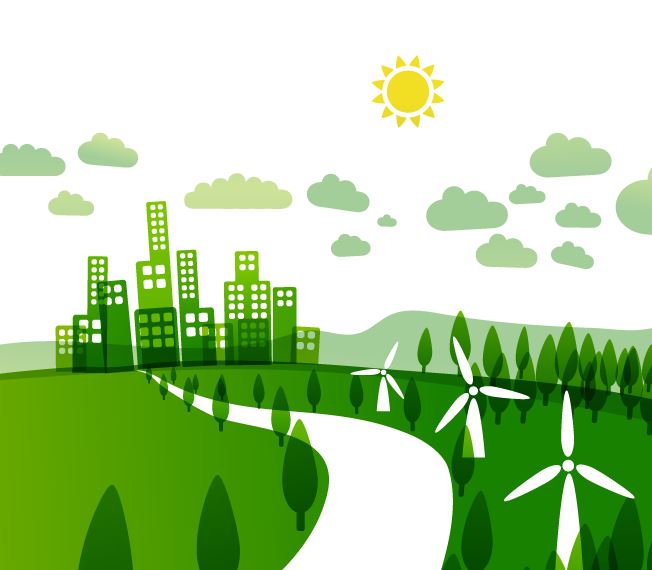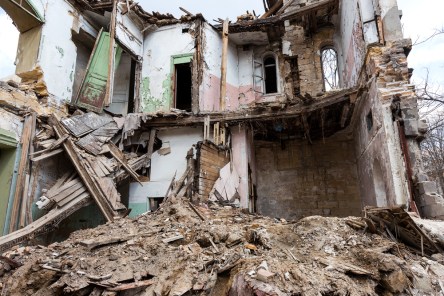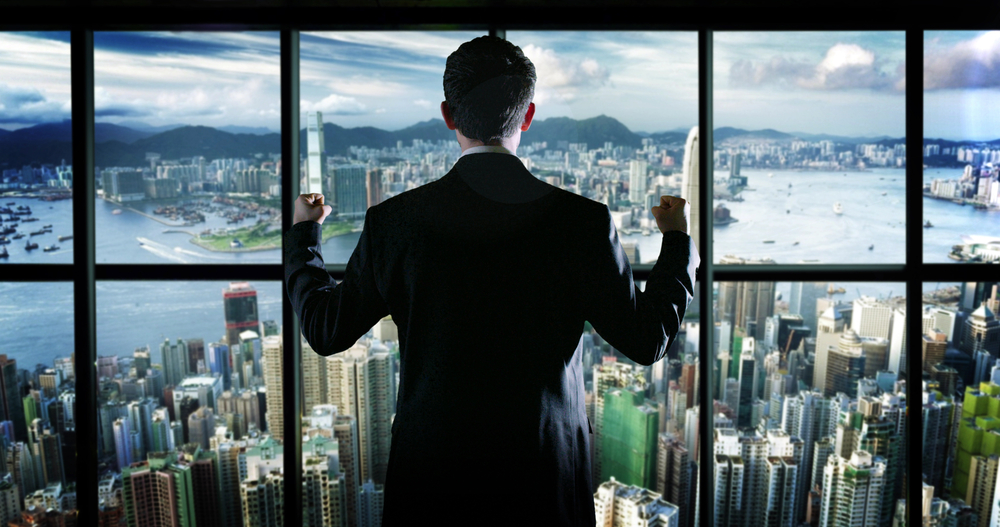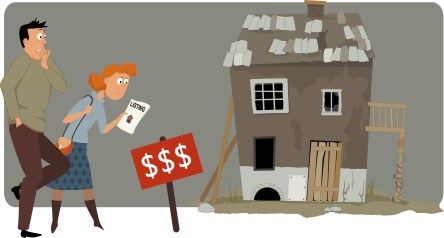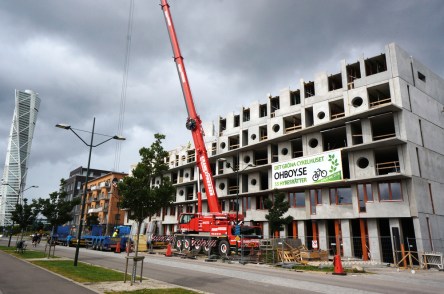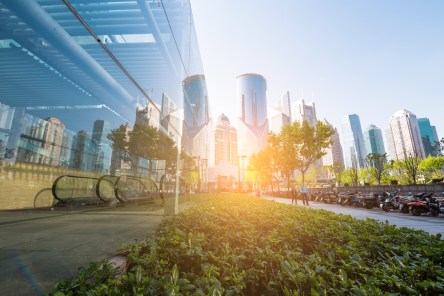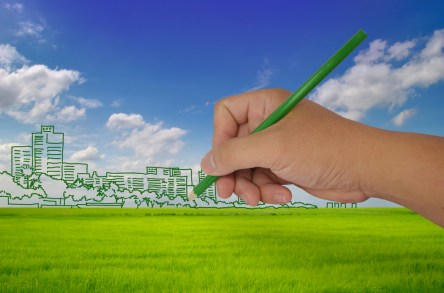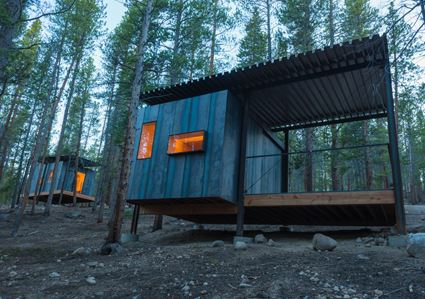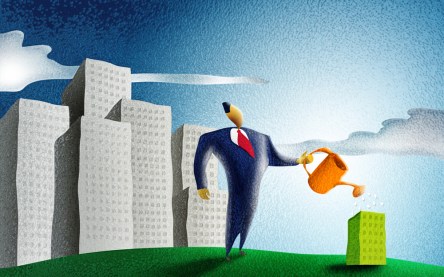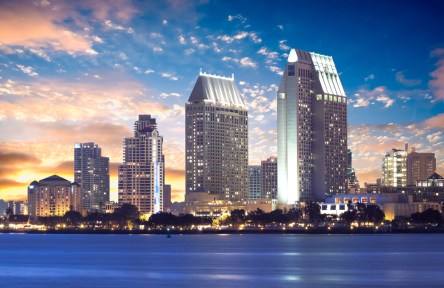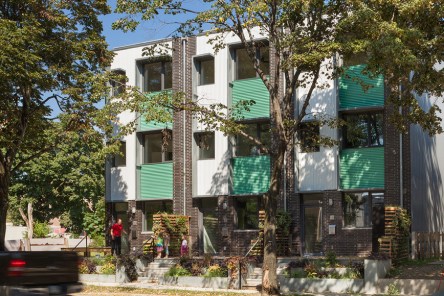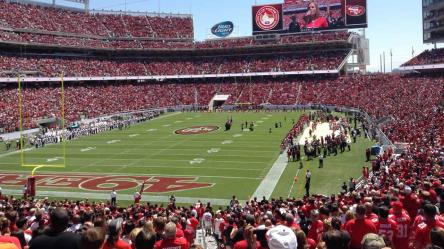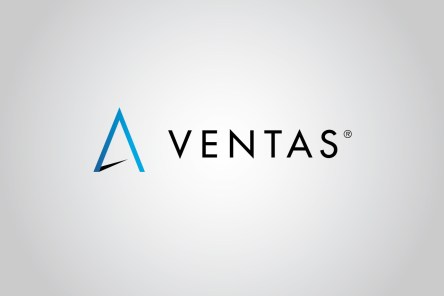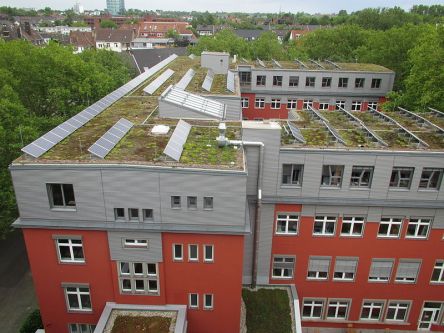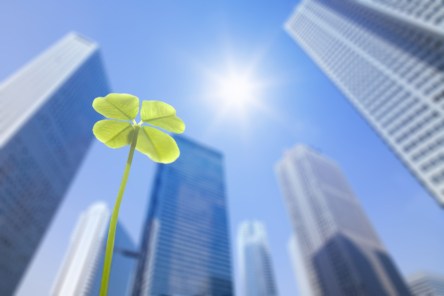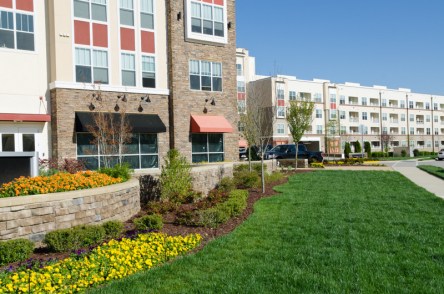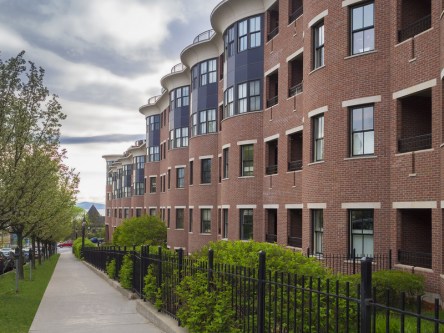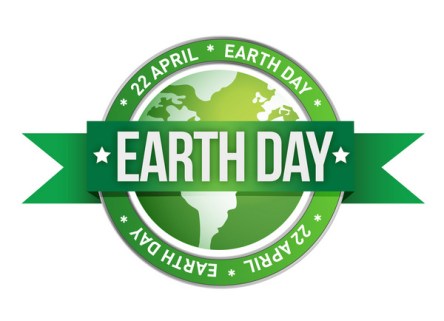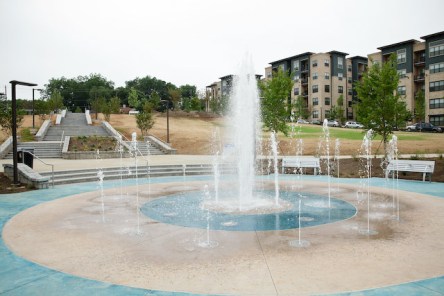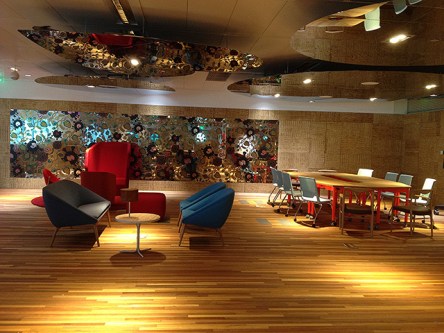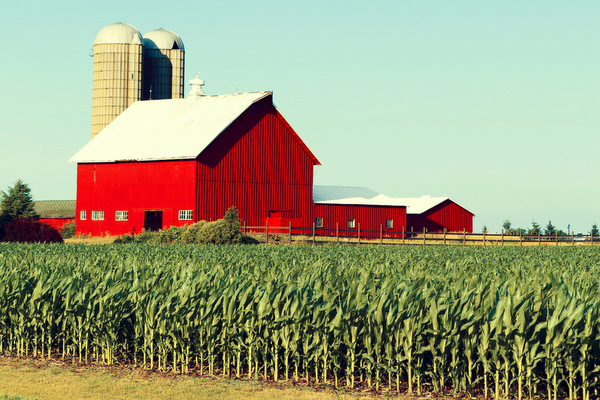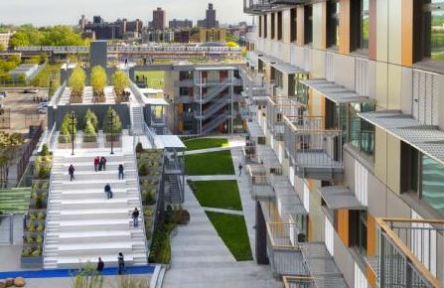Commercial building owners, tenants and brokers need the right tools to incorporate energy efficiency into leases. A program called Green Lease Leaders stands ready to provide them. Green Lease Leaders helps real estate practitioners create leases that promote collaboration on investments such as high-efficiency rooftop air handling units, lighting retrofits, water irrigation upgrades and solar panels. The program was the subject of a recent webinar, “How to Become a Green Lease Leader: The Latest in High-Performance Leasing Practices and Recognition.” Presenters included Holly Carr, a Department of Energy technology program specialist, Sara Neff, senior vice president of sustainability for Yardi client Kilroy Realty Corporation, and Alexandra Harry, program manager, market engagement for the Institute for Market Transformation (IMT). Green Lease Leaders was developed in 2014 by IMT, a Washington, D.C. nonprofit and the webinar’s host, with support from the Energy Department’s Better Buildings Alliance. IMT works to unlock building energy efficiency that it says could save the U.S. office market $3.3 billion annually and cut energy consumption by 22% in leased buildings. The program currently includes landlords, tenants and brokers who represent 1.3 billion square feet of commercial, industrial and retail space. “Tenants and landlords share an obligation to understand how much energy their buildings use and jointly share the cost of upgrades as well as the resulting maintenance savings and best practices,” Carr said. “Benefits of green leasing include reducing utility bills by up to 51 cents per square foot, increased net operating income, reduced occupancy costs, increased occupant satisfaction, fewer greenhouse gas emissions and improved landlord-tenant communication and relationships.” Along with defining new best practices for energy efficiency in buildings, the program also offers participants technical support, peer networking opportunities, tools for comparing current leases to Green Lease Leaders standards and other...
Better Building
Mitigating Disaster Impacts
As several devastating natural disasters have leveled towns and stalled economies, industry attention returns to smarter building. Construction professionals seek materials that are durable, versatile, and sustainable. An existing concrete product may be the key to better building. Conventional concrete—the go-to material for low- and mid-rise buildings— lacks the combination of compressive strength, tensile strength, and durability needed to withstand high magnitude earthquakes and daily wear. Concrete cracks, crumbles and collapses during earthquakes, leaving high repair costs and the potential loss of life. Researchers at the University of British Columbia (UBC) sought to improve upon concrete without increasing the cost of construction. Their creation, eco-friendly ductile cementitious composite (EDCC), eclipses conventional concrete in three ways. Sustainability Conventional concrete production is a leading contributor to greenhouse gas, totaling 7 percent of global emissions. EDCC replaces 70 percent of cement with fly ash, which reduces the levels of carbon dioxide emitted. Additionally, EDCC reduces land and water pollution. The fly ash in EDCC is industrial waste that would otherwise end up in landfills or dumped into rivers and streams. Strength + Malleability Once dry, EDCC becomes as strong as steel yet is much more flexible. A half-inch thick concrete wall can resist a magnitude 9 earthquake when sprayed with a layer of EDCC 10 millimeters thick, UBC reports. Without the EDCC reinforcement, a wall of that thickness would collapse at 65 percent intensity. Versatility EDCC is a sprayable concrete mixture that can be used to reinforce and support thin concrete walls. Thinner concrete walls expand design possibilities without limiting the integrity of the structure. The spray facilitates easier application and a broader range of uses. Builders and engineers are already using the fiber-reinforced concrete to create in schools and businesses. EDCC can also be applied to...
Benchmarking Bonus
NAA Return on Energy
Currently, over 45% of the US commercial building market uses the ENERGY STAR®, the US EPA’s voluntary certification program designed to measure energy efficiency and improve resource management. At the heart of ENERGY STAR® lies the ability to track energy usage data to reduce energy consumption and improve building performance. “It all starts with taking a look at what you have and seeing what [information] you’re tracking and what data is available,” Craig Haglund, Program Manager, for the US EPA’s ENERGY STAR program, said in the National Apartment Association’s recent webinar, Financial Success with Energy Benchmarking. With comprehensive data collection and analytics capabilities, US EPA’s Portfolio Manager works in concert with ENERGY STAR for complete resource management oversight. “They say ‘you can’t manage what you can’t measure,’ which is 100% true,” Haglund continued, “but that misses what you can do with all that data.” Whole Building Consumption For building owners and managers interested in tracking their energy, water and waste metrics, ENERGY STAR provides an easy, comprehensive management tool: Portfolio Manager. With Portfolio Manager, building data can be tracked and analyzed. Users can create customized reports and monitor changes in energy, water, greenhouse gas emissions and more. “Portfolio Manager literally includes hundreds of measurement metrics,” explained Haglund. “Standardized reports can help users assess portfolio performance and share that information or integrate it into other presentations.” Those measurement metrics can be applied to any sized property portfolio, from one building to, in the case of East Coast real estate services firm Bozzuto Management, 63,000 units spread out over 220 communities and representing 2.1 million square feet of mixed-use development. “We have been using Portfolio Manager since 2012,” said Bozzuto’s Director of Sustainability, Peter Zadoretzky. “Over the last couple of years, we’ve gone from a messy,...
Most Sustainable Companies
Yardi Clients Shine
Forbes recently released the 2017 World’s Most Sustainable Companies list. Yardi is proud to acknowledge one client and two partners whose sustainable initiatives earned placement on the list. Toronto-based magazine and research firm Corporate Knights has issued a list of the world’s most sustainable companies since 1995. The list is comprised of companies with market values of at least $2 billion. Each company must excel in 14 metrics that examine its management of finances, resources, and employees. The list demonstrates that when companies invest in sustainability, they become more profitable. Forbes explains, “the Global 100’s cumulative return is 24 percentage points higher than the ACWI benchmark.” Of those profitable companies, Yardi client Prologis returns to the World’s Most Sustainable Companies list yet again. The Colorado-based company celebrates a decade on the list this year. “We place high value on being a responsible corporate citizen,” says Arthur Nelson, VP Global Business Systems in an interview with Yardi. “One key element of that commitment is developing to internationally recognized sustainable building standards including LEED, BREEAM, CASBEE, HQE and DGNB, with the goal of certification.” Prologis also requires compliance from vendors. The Supplier Code of Conduct defines ethical, environmental and social principles for all supply chain partners. The code emphasizes the necessity of sustainable and ethical practices throughout multiple levels of the organization. Yardi would also like to recognize our partners Cisco and General Electric for their ranking amongst the World’s Most Sustainable Companies of...
Affordability Crisis
Toolkit for Development
While the ghosts of the last decade’s housing crisis have (mostly) been put to rest, for many families priced out of their local markets the need for affordable housing remains strong. Like the PC’s infamous “blue screen of death,” the Urban Institute’s map of affordable housing inventory is terrifying to behold. A handful of dark blue swatches in Midwest represent healthy levels of affordable housing inventory. The rest of the country, on the other hand, sits awash in the lightest indigo hues. From barely perceptible azure to the palest cerulean, a majority of states contain less than 50 units per 100 extremely low-income households. More than a third sit at, or close, to zero. As demand for budget-friendly rentals continues to rise, many communities struggle to provide adequate supply. In response to this affordable housing crisis, the White House recently released the Housing Development Toolkit. Part call to action, part policy overhaul, the toolkit’s main purpose it to help cities increase their affordable housing inventory. “The growing severity of unsupplied housing markets is jeopardizing housing affordability for working families,” write the toolkit’s authors, “increasing income inequality by reducing less-skilled workers’ access to high-wage labor markets, and stifling GDP growth by driving labor migration away from the most productive regions,” Accumulated Barriers While New York City’s real estate market is the stuff of legend, until recently most cities were able to supply adequate housing to residents. Unfortunately, several factors have conspired over the last few years to shrink stock and ramp up costs. These “accumulated barriers” are identified by the toolkit as lack of adequate construction, high job growth in areas with low vacancy rates, gentrification, and cost-per-unit increases paired with insufficient public assistance. “The accumulation of these barriers has reduced the ability of many housing markets to...
Pedal Power
Bike Apartments
In bike-friendly Sweden, a new apartment complex includes custom design elements aimed at encouraging residents to ditch cars in favor of pedal power. For many urban apartment dwellers, parking spots and constant traffic severely undercut the benefits of living within the city limits. Sure, public transportation, walking, and cycling are all reasonable alternatives to private automobiles, but sometimes the hassles outweigh the benefits. In Malmö, Sweden, a new apartment complex is ditching carports for bike racks in the hopes that future tenants will embrace a car-free existence. “It’s a perfect city for biking,” says Cykelhuset Ohboy spokesperson Ellen Mendel-Hartvig. “It’s super flat, and you can get anywhere within 15 minutes.” Centrally Cycling Located just minutes from the city center, Cykelhuset Ohboy, a 7-story bicycle house/hotel, is an easy trek by foot or bike from major shopping districts and even the central train station. Large delivery mailboxes will help resident shop online for items that might be too difficult to transport without a car, though the building’s fleet of cargo-bikes will also help with heavy loads and even help parents transport their children to school or daycare. “The strategy is to look at why people have to use cars, and substitute bikes, “Cord Siegel, one of the architects at Hauschild + Siegel, which designed Cykelhuset Ohboy, tells Fast Company in a recent interview. The Un-Motor Lodge In addition to 55 one to four-bedroom units, Cykelhuset Ohboy will also double as a hotel, with 31 lofts available for nightly rentals. Available for shorter tenancies – a few weeks to a month or two, the 237-sqft lofts include a small kitchen and can sleep up to three people. In a play on the traditional “motor-lodge,” guests will be able to ride their bike right up to their...
Bentall Kennedy
ROI on Sustainable Assets
Yardi client Bentall Kennedy recently released a report that may change the way that the industry sees sustainable building. Giselle Gagnon, Senior Vice President, Strategic Resources Group explains, “Our team at Bentall Kennedy has long been committed to implementing sustainability practices across our managed property portfolio – for us it demonstrates to our clients and tenants that we are investing soundly and sustainably,” she says. “So we commissioned a study to seek research-based evidence to test our hypothesis that green office building certifications deliver higher value.” Sustainability within the commercial sector is a vital component of environmental health and corporate efficiency. Commercial properties are responsible for 81 percent of electricity consumption across North American and Europe. The industry also accounts for 40 percent of all energy consumed in those continents. Until now, stakeholders did not have the resources needed to determine which green building certification would be the most effective, yielding the highest returns and making the smallest impact on the environment. Previous studies fell short in a number of ways: All were based on publicly available information, such as posted asking rents, green building certifications and the sale price of assets. The majority excluded data on concessions and their effect on net rents. Many studies overlooked intangible benefits entirely. None examined actual in-depth, diverse metrics across a large office portfolio for as long as 10 years. As a recognized leader in Responsible Property Investing, Bentall Kennedy filled those voids. The company commissioned a comprehensive, long-term study on the benefits of sustainable certifications for commercial properties. In late 2015, The Journal of Portfolio Management published a report of the study entitled, “Green Certification and Building Performance: Implications for Tangibles and Intangibles.” “The study is unique in that, in addition to financial metrics, it looks...
LEED Losing Favor
New Certifications Gain Ground
United States Green Building Council (USGBC) Leadership in Energy and Environmental Design (LEED) program may be losing clout as the leader of sustainable building certifications in America. Developers seek alternative certification methods to cut capital costs while keeping buildings green. When JDS Development Group CEO Michael Stern spoke at a recent real estate summit in New York, he didn’t mince words: “I think the LEED criteria is totally arbitrary and LEED has basically devolved into a self-sustaining revenue machine for LEED consultants without actually moving the bar that much,” he said. “You can have a LEED project basically anywhere near transportation. You qualify for enough points if you pay enough money.” Others on the panel shared his sentiments. Dissatisfaction with the cost of certification questions the data LEED shares on the costs of eligible projects. According to the Dodge Data & Analytics and United Technologies Corporation, about 70 percent of respondents quote high perceived cost as the biggest challenge to sustainable building. A Health Facilities Management report claims that LEED certification capital costs can exceed 10 percent of conventional construction. Conversely, LEED’s report, “Perspectives on Capital Costs Premiums and Operational Benefits” suggests that the capital costs of hospitals exceeding 100,000 square feet barely reach 1 percent of conventional costs. A US News editorial asserts that LEED credentials on government buildings do not add value. Moreover, taxpayer returns are lower than promised. The article suggests that, in spite of the costs, regulations are unlikely to change since governments reap millions of dollars in permit fees. Fortunately, the cost discrepancies have not turned LEED cynics away from sustainable construction. Developers are investing in alternative accreditations or use LEED as a guideline without paying for the certification. Builders have several green building certifications from which to choose. The newest...
Cabin-Style Dorms
Student Housing
With an eye towards sustainability and passive building principals, University of Colorado Denver’s prefab, cabin-style dorms connect modern architecture with outdoor living. Just outside Denver, Colorado sits a cluster of 14 micro dormitories outfitted with all the essentials necessary for comfortable, environmentally-friendly cabin living. Created in partnership with Outward Bound, the micro dorm project was developed by 28 University of Colorado Denver, graduate students participating in CU-Denver’s Colorado Building Workshop. Hands-On and Creative Established in 1991, the Colorado Building Workshop began as part of an effort to pair non-profits with innovative architectural projects. With an emphasis on promoting hands-on skills and creative design, workshop participants use cutting-edge materials and inventive design to produce buildings for disadvantaged communities. Graduate students from CU-Denver’s Studio IV must apply to be part of the workshop. If accepted, they are required to complete 18 credit hours of the Design Build Certificate. The course of study emphasizes both the basics of Design Build and Integrated Project Delivery. The program’s courses cover topics focused on quality and risk management, along with group assignments requiring students to work together to shepherd a project from initial concept to completion. “Collaboration is the core principle of the design-build program,” declares the program’s website. “We are thankful to all the businesses and individuals who support this work and recognize its importance in the local community.” Two Structures, One Footprint Rick Sommerfeld, founder and director of Colorado Building Workshop, set out with his students to create living spaces capable of coexisting with the land. As a result, their final design make the most of open-air entry-points while also providing basic living quarters. With front-facing decks and floorplans that “sit lightly on the landscape,” each individual unit balances private and community spaces. Surrounded by pine forest and...
Investing in Humanity...
Sustainable Investments
Curious about sustainable investments? You’re not alone. Sustainable investments result in better operational performance, improved stock prices, and proven psychological benefits. So why aren’t more advisors talking about it? JP Morgan defines sustainable investments as “investment approaches that enable investors to integrate environmental, social and governance (ESG) considerations into their investment strategies and create positive benefits for society.” In 2014, an estimated $21.4 trillion of global assets were reported as sustainable investments. That is an $8 trillion increase from 2012. This field of investment continues to grow due to favorable results: The University of Oxford and Arabesque Partners reports that 88% of companies that practiced effective ESG management were also able to improve operational performance. Stock prices performance improved for 80 percent of companies that prioritized ESG issues. JP Morgan and the University of Oxford have not analyzed the warm and fuzzy sensation that can come as a result of investments with a higher purpose. But others have. New York Times compiled several studies that examine the connection between acting for the greater good and emotions. Sources conclude that supporting causes that we feel good about reduces stress levels and can even extend lifespans. When we feel positively about a cause that we support, we are more likely to support that cause wholeheartedly and consistently. Do-gooding simply makes us feel better about ourselves and the prospects of the world that we live in. Meir Statman’s What Investors Really Want explains that investors value an emotional connection with the company or organization in which they are investing. Such strong emotions can “drive prices and performance above the funds and fundamentals involved,” reports JP Morgan. With financial and personal benefits to gain, why aren’t more asset managers broaching the topic with clients? Only 63 percent of...
Renewable City
Clean Energy for San Diego
Blessed with an average of 266 sunny days per year, it’s no surprise San Diego currently generates 189 megawatts of solar power. Though it boasts the second highest solar wattage in the country, the city doesn’t plan to rest on its laurels. Instead, this southern California metropolis of over 1 million has set its sights on something grander: to be largest U.S. city completely powered by renewable energy. Known as the “birthplace of California,” this trans-border urban outpost sits at the center of U.S. innovation, playing host to military, biotechnology and medical research and manufacturing. Over the years, San Diego’s commitment to sustainability and environmentally focused city planning has resulted in an extensive infrastructure renaissance and citywide green initiatives. With an eye on reducing carbon emissions and mitigating the effects of global warming, a bipartisan coalition led by Republican Mayor Kevin Faulconer unanimously approved the city’s Climate Action Plan last December. The goal is to cut greenhouse gas emissions and shift to 100% renewable energy sources by 2035. The Climate Action Plan also includes a goal of 90% solid waste recycling along with significant funding for public transportation. “Today, we are faced with an issue that affects us all. Our city’s responsibility is to ensure a clean, sustainable San Diego for generations to come,” Faulconer writes in his introduction to the Climate Action Plan. “San Diegans from different backgrounds are coming together to proactively address environmental concerns, strengthen our economy and improve our quality of life.” The Climate Action Plan includes practical policies designed to strike a balance between environmental protection and economic opportunity. Those strategies include improved water resource management, targeted public information campaigns, and green jobs incentives. “We have an opportunity to improve the lives of every San Diegan,” concludes Faulconer. “This...
A Passive Phase
Sustainable construction trend
With the U.S. building sector accounting for 7% of global primary energy consumption, residential and commercial property developers are turning towards modern solutions, like Passive Homes, to increase energy efficiency in new and renovated properties. Big Apple Energy While it might be “the city that never sleeps,” it wouldn’t hurt to turn a light off once in a while! Though it’s probably no surprise to learn that many of New York city’s most expensive buildings aren’t particularly energy efficient, in truth the numbers are quite shocking: 70% of the city’s emissions are generated from New York City buildings. Even more eye opening…2% of those buildings account for more than half of the city’s energy use. According to the advocacy group Climate Works for All, ten of New York’s most expensive buildings score an “F” in terms of energy efficiency based on Energy Use Intensity. With several more luxury high rises and condominiums in the works, many property developers are looking for ways to lower the energy footprint of their buildings. One solution: Passive House Technologies. A Borough Apart As all things fashionable and hip, Brooklyn is the epicenter of New York City’s passive house movement. In fact, a majority of the New York’s 28 passive building projects are located in or around Brooklyn, including homes in Williamsburg, townhouses in Park Place, and condominiums in Prospect Heights. Some of the passive properties are new constructions projects, but many more are retrofits of existing structures, including a historic house in Brooklyn Heights whose classic façade remains unchanged, despite the addition of super insulation around its double-height windows. In all, Brooklyn is home to more than 20 residences and commercial buildings that fit the passive house guidelines, but because many property owners follow the standards without seeking...
Golden Bowl
Levi's Stadium hosts Super Bowl 50
On February 7, 2016, the Carolina Panthers and the Denver Broncos will battle it out at Super Bowl 50 in the LEED Gold Certified Levi’s Stadium; one of the nation’s most technologically advanced sporting venues. Three years ago, a thrilling super bowl featuring a rally by the San Francisco 49ers during the second half turned a would-be shutout into a hard-fought, 34-31 win for the Baltimore Ravens. Though the game was action packed, one of the most startling moments happened right after halftime when the entire 73,000-seat arena went dark for 34 minutes. When the lights returned, the 49ers rallied, closing a 28-6 halftime score and almost sparking what might have been “the greatest comeback in Super Bowl history.” Clearly the 49ers took that blackout to heart, as evidenced by the team’s own Levi’s® Stadium, a state-of-the-art sporting facility touted as “the most high-tech stadium in the world.” An Homage to the Future “The stadium is built in the middle of the heart of technology,” declares Senior VP of NRG Business Solutions Robert Gaudette in an NRG video of the building’s construction. “It’s also at the center aisle of the newest thinking around what energy is.” Dan Williams, former VP of Technology for the 49ers expands on how technology was paramount as plans for the building evolved, saying “One of the focuses was ‘let’s ensure that it’s truly a technology driven stadium, and let’s try to adopt what makes Silicon Valley Great.’” Recognized as “2015 Sports Facility of the Year” by Sports Business Journal and “Venue of the Year” by The Stadium Business Awards (Barcelona, Spain), Levi’s® Stadium was also awarded LEED Gold certification by the U.S. Green Building Council (USGBC), the first NFL stadium to earn that designation. “When we looked at building this...
Ventas’ Vision
Sustainable Senior Living
In the trillion-dollar healthcare real estate market, success is often measured by continued revenue growth and steady asset appreciation, but Ventas is taking a more holistic approach. Ventas Inc., an S&P 500 company, is considered one of the nation’s leading real estate health-care investment trusts (REIT). With a market value of $18 billion, the company’s property portfolio includes everything from acute care hospitals and skilled nursing facilities to senior housing communities. In 2014, the company decided to initiate a series of building improvements designed to reduce energy use and water consumption while also managing and lowering utility costs. The retrofit projects may have been conceived with an eye on the bottom line, but saving money was not the only goal. As Brian Fry, director of asset management at Ventas, recently explained to Senior Housing News, the company looks at this commitment to increased building efficiency “through a bit of a different lens than just dollars and cents.” According to Fry, who heads up Ventas sustainability projects, the ultimate objective is “improving building quality and promoting healthier living and care environment.” Saving Energy, Water and Cash Last year, the company committed $3.8 million for building rehabilitation and structural improvements at several of its senior housing communities. So far, the company has focused on properties in New York, Pennsylvania and New Jersey. The improvements have included replacement of lighting and electrical fixtures, along with upgrades to plumbing and other improvements. The upgraded facilities have already experienced a reduction in energy and water consumption, and the utility costs have decreased as well. But even more importantly for this publicly traded company beholden to stockholder expectations, the ROI on these sustainability projects has been exceptional. In fact, Fry predicts company’s 2014 sustainability projects will provide payback in less...
Yeloha
Panel-less solar power
The price for photovoltaic cells is plunging, in the last six years it has fallen by at least 50 percent. According to a Gallup poll, 79 percent of Americans expressed the interest for the U.S. to develop more solar power. The product is already growing, accounting for 36 percent of all new electric capacity through the first nine months of 2014, according to the Solar Energy Industries Association. Although on an upward swing, solar power has yet a lot of catching up to do. The U.S. Energy Information Administration reports that the United States generated approximately 4,093 billion kWh of electricity in 2014. The most part of the electricity (two-thirds) came from fossil fuels (mainly coal and natural gas), and one-fifth from nuclear. Solar accounted for only 0.4 percent. The reasons are various: the roof is facing the wrong way or needs replacing, there is too much shading from mature trees or other buildings, the renter status which doesn’t give them the right to make such a decision, simply lacking those 10 or 15 grand to pay for installation, or the not-so-good credit that cuts any possibility of financing or long-term purchase agreement. The future looks different. A new sharing platform dubbed Yeloha focuses on a new approach, which combines the power of social networks and the attractiveness of the sharing economy, aiming to offer solar power regardless of location of income level. What’s the plan? Yeloha has two types of customers—sun hosts and sun partners. The sun hosts are represented by the people living under eligible sunny roofs, but can’t afford the costs for the panels. In their case, Yeloha will install its own panels at no cost and give them a portion (typically one-third) of the electricity they produce, for free. In...
Glorious Green Roofs
Renewable Future
France, the epicenter of style and fashion, has recently dealt a blow to the detractors of solar panels and green roofs by passing legislation that will require all new commercial buildings to feature green roofs. New buildings constructed in French commercial zones will have to be partially covered by either living foliage or solar panels, under the new law, which, albeit less drastic than its initial form (which would have applied to all buildings and the entire surface of roofs), will have a significant impact. Installing solar panels will obviously add green energy to France’s massive energy appetite. Green roofs will bring their own plethora of environmentally friendly features. Higher costs –bigger returns Green roofs significantly increase the insulation of a structure, thus decreasing the need for air conditioning and heating. According to a recent study by Universidad Politécnica de Madrid and Università Politecnica delle Marche researchers, roofs with dense vegetation are 60 percent more efficient than traditional roofs and can in fact act as passive cooling systems. Furthermore green roofs absorb less heat during the day than traditional roofs, thus lowering the heat island effect that plagues cities, especially large urban environments. This is further exacerbated by the fact that green roofs release less energy during the night than they absorb during the day. Moreover, green roofs absorb a large quantity of rainwater, reducing runoff, decreasing the pressure put on city sewage systems, especially during large weather events. When local and/or drought-resistant flora is used for green roofs, there is little to no added water consumption. Green roofs also contribute to healthier environments by absorbing pollutants and releasing oxygen and providing shelter and nesting places for birds and small local fauna, contributing to local biodiversity. Green roofs can also be used as gardens...
Value Quantified
Office Tenants + Sustainability
Research by DTZ, one of the top three global commercial real estate services companies in the nation, has quantified the perceived benefits of sustainable office spaces. The studies are helping owners channel their efforts towards features that are most valuable to tenants. In 2014, studies by Nils Kok, Ph.D., executive director of the Global Real Estate Sustainability Benchmark (GRESB), helped to establish the financial benefits of sustainable construction. Kok’s findings revealed that sustainable office buildings trade at a 13 percent premium over conventional buildings, receive rental rates that are at least 3 percent higher, and increase internal rates of return by as much as 6 percent in less than 15 years. New research by DTZ examines the correlation between tenant surveys and the buildings that tenants occupy. More specifically, the team evaluated responses to Kingsley Associates’ tenant surveys with 61 buildings in Washington, D.C. Allison Porter, vice president of sustainability certifications at DTZ, reports that sustainable features positively influence tenants perception of their workplace. “The results seem to show that tenants who are in sustainable buildings are more satisfied,” Porter says. “We already know that tenant satisfaction leads to tenant retention, which decreases vacancy and rollover costs.” Tenant satisfaction is preceded by two major factors: knowing that the building is green and experiencing the benefits of its sustainable features. Even the greenest building with the best environmental and tenant wellness upgrades will fall flat with tenants if it is not certified by a third party. The DTZ report revealed that buildings with posted Energy Star certifications scored higher than buildings without the certification by an average of 30 points. LEED EB certified buildings received ranking increases averaging 10 points higher than non-certified buildings. Office buildings must also have the sustainable features that tenants appreciate....
Passive Retention
Maximizing landscaping
As building permits increase this year and healthy competition is restored, multifamily must revisit resident retention practices. Luxury amenities, home automation technology, and quarterly vacation giveaways are unsustainable: amenities and technology quickly become outdated, requiring costly upgrades, and it’s hard to find room in the budget for grandiose vacation packages. What feature can increase tenant retention over the long term without significantly raising costs? Greenery. A series of studies suggests that renters can feel better about their communities and happier with themselves through strategic landscaping. According to a study released by Kansas State University, views of nature contribute to resident satisfaction by making residents feel happier and healthier. The lush landscaping and interactive green spaces in such residences enhance tenants’ sense of health and well-being by reducing stress and anxiety, invigorating the senses, and ameliorating urban harshness. The beneficial effects of nature apply to tenants of all ages. In “Visual Landscapes and Psychological Wellbeing ” by R.S. Ulrich, green spaces demonstrably improved students’ focus, productivity and confidence before taking tests. Greenery also decreased students’ stress levels. Housing that can offer students better academic performance and stress mitigation will be an easy sell in a competitive market. Mental Health and Function by University of Washington departments of Urban Forestry and Urban Greening Research compared seniors living in apartments with greenery to seniors without access to nature. Overall, seniors preferred greener communities. Seniors living near greenery used such spaces for recreation, exercise, and social interaction. As a result, they felt that green spaces contributed positively to their well-being, happiness, and vitality. Seniors revealed a positive correlation between greenery and a diminished sense of loneliness, fewer cases of depression, and lower mortality rates. Greenery can also improve resident retention by promoting peace between neighbors. Mental Health and...
HUD Cuts
Improvement funds fall short
The U.S. Department of Housing and Urban Development (HUD) granted $1.8 billion to public housing authorities throughout the nation. The funds will allow properties to make major renovations to existing properties that improve habitability andsustainability. The grant falls woefully short of the estimated $25.6 billion needed to bring the nation’s 1.1 million public housing units up to par. The inadequate award signals the continuation of the affordable housing crisis. Each state and many US territories received Capital Fund Programs grants to construct, repair, and renovate public housing communities. Projects range from necessary structural repairs to upgrades that improve sustainability and the cost-effectiveness of the properties. The Capital Needs in the Public Housing Program suggests that the nation’s 3,100 public housing authorities will require nearly 12 times the awarded amount to make units “decent and economically sustainable.” The recent award follows a string of budget cuts to HUD, USDA Rural Development, and other affordability-centered programs. The President’s proposed FY 2015 budget outlines further cuts. HUD is estimated to lose $32.6 billion. The lack of funding adds to a continuing concern over the affordable housing crisis. Across the board, the nation’s lowest-income members encounter mounting barriers to housing. National Low-Income Housing Coalition’s (NLIHC) “Out of Reach” report concludes that there are only 31 affordable housing units for every 100 families in need; Urban Institute states that for every 100 extremely low-income (ELI) renter households, there are only 29 affordable and available rental units. Not a single county in the nation has reached equilibrium between ELI households and available affordable housing. While a lack of available units is part of the problem, it isn’t the sole concern. Even with units available, some families cannot obtain the assistance needed to move in. According to the Center for American Progress,...
Earth Day
Creative community celebrations
There’s no better time than the present to start making a difference; and the best place to start is in your own community. Not only is Earth Day right around the corner, but eco-friendly action can help Mother Nature thrive. First celebrated on April 22, 1970, Earth Day was launched to honor our planet, acknowledge its fragility and promote the development of healthy communities. It was initiated by Earth Day founder Gaylord Nelson, then a U.S. Senator from Wisconsin, after witnessing the terrible aftermath of the 1969 massive oil spill in Santa Barbara, Calif. (The hometown of Yardi.) The first Earth Day led to the creation of the United States Environmental Protection Agency and the passage of the Clean Air, Clean Water, and Endangered Species Acts. “It was a gamble,” Gaylord later commented, “but it worked”. What started as a “national teach-in on the environment” has now evolved onto a global-scale movement observed in over 192 countries around the world. At present, more than one billion eco-minded participants worldwide take the opportunity to demonstrate their commitment next Tuesday through events and festivities all focused on environmental issues. The movement is globally coordinated by the Earth Day Network (EDN). From tackling global warming issues to greening schools and hosting town hall discussions on clean energy investment and green jobs, EDN has many projects on roll. Among the many successful campaigns, the movement’s 40th anniversary made quite a splash. In 2010, EDN brought “225,000 people to the National Mall for a Climate Rally, amassed 40 million environmental service actions toward its 2012 goal of A Billion Acts of Green®, launched an international, 1-million tree planting initiative with Avatar director James Cameron and tripled its online base to over 900,000 community members”. Saving a thought for the environment becomes even...
Healthy Places
Enhancing the Built Environment
The built environment has a huge impact on every aspect of human life. The places in which we live, work and play can affect both our mental and physical wellbeing. As a promoter of healthy communities, the Urban Land Institute (ULI) has launched a series of projects aimed at encouraging sustainable living choices among urban dwellers, including Ten Principles for Building Healthy Places and Intersections: Health and the Built Environment. The two reports are part of the Building Healthy Places Initiative, a multifaceted program launched in July 2013 by ULI to purposely “leverage the power of the Institute’s global networks to shape projects and places in ways that improve the health of people and communities.” Over the next couple of years, ULI and its members will explore issues of land use, urban design and development so as to delineate clear paths which will eventually lead to the creation of nurturing living environments, conducive to active lifestyles, social interaction, and a higher quality of life in general. “We are looking at city building through the lens of health and wellness as a way to measure sustainability and long term prosperity,” said ULI Chairman Lynn Thurber, chairman of LaSalle Investment Management in Chicago, in a written statement. “The Building Healthy Places Initiative is an extension of ULI’s ongoing pursuit of sustainable, thriving communities worldwide. The difference is that, with this effort, wellness is the intent, the designated outcome – not just an additional benefit of thoughtful design and development. Our focus will be on defining the role land use plays in creating healthy places for all generations.” Intersections: Health and the Built Environment builds on the premise that intelligent urban design can help put an end to many of the ills currently menacing communities all across...
LEED v4 Goes Live
Coherence & Efficiency
The U.S. Green Building Council (USGBC) officially launched LEED v4, the newest version of the LEED green building program, at the Greenbuild International Conference and Expo in Philadelphia. Ever since the first LEED Pilot Project Program (also known as LEED Version 1.0) was introduced at the USGBC Membership Summit in August 1998, the LEED, or Leadership in Energy & Environmental Design program, has revolutionized the way buildings and communities are designed, constructed and operated. Whereas the first series of rating systems were developed to largely address the needs of owner-occupied new construction commercial buildings, the program has grown, evolved and expanded to encompass the different project development and delivery processes that exist in the U.S. building design and construction market, through rating systems for specific building typologies, sectors and project scopes: Core & Shell Development, New Construction and Major Renovations, Schools, Existing Buildings: Operations & Maintenance, Neighborhood Development, Retail, Healthcare, Homes, and Commercial Interiors. Moreover, LEED seeks to accelerate green building demand, delivery and accessibility and optimize the use of natural resources. While still based on the essential principles advocated by its previous versions, LEED v4 brings a plus of coherence and efficiency to the whole process. “LEED v4 is a quantum leap for LEED,” said Rick Fedrizzi, president, CEO and founding chair, USGBC. “Over the past 15 years, LEED has fundamentally revolutionized how we design, construct, operate and maintain our buildings and communities. LEED has created a completely new industry of business enterprise committed to energy savings and efficiency. LEED v4 is as much a testament to the achievements of LEED project teams around the world as it is to the green building community’s ambition to create significant global and local change through resource-efficient, cost-effective green buildings.” The program’s goal is to foster...
Agriburbia
Developing amidst farmland
The community garden just isn’t big enough anymore. And when it comes to creating a residential neighborhood that will embody sustainable practices, the local food movement, and love of open spaces, agriburbia has come forward as an exciting alternative. Never heard of it? Neither had I, until a few weeks ago. But just the name agriburbia instantly interested me. I pictured strip malls being razed for cornfields in the suburbs, a farm stand on every corner, organic, local-sourced salad on every dinner table. Impossible utopia? Not quite. Agriburbia, it turns out, is already thriving in numerous states around the nation. My research revealed experiments with the model in Virginia, Vermont, North Carolina, Idaho, Illinois, Georgia, Wisconsin, Colorado and California. It’s also catching on in Canada, where it’s the focus of an academic research effort. “The resulting agriburban zones, defined as suburban forms in which agriculture plays a significant role, are of increasing importance as a site of local food production, of affordable housing on the urban fringe, and of settlement regions for migrants from agrarian backgrounds,” notes the Agriburban Research Center at the University of Fraser Valley. The logic is simple: growing food in far-off places, and shipping it to grocery stores, only decreases quality and increases cost. Once upon a time in North America, we grew the produce and raised the animals we needed to live right in our own communities. As cities and suburbs grew fast and furious, farms were pushed further and further to the outskirts. The agriburbia movement aims to bring them back into view. The Urban Land Institute estimates that up to 200 such projects are developed or in progress. According to Agriburbia.com, there are 3,000 acres of such land in or under development and production. Imagine wandering out onto the back porch to be greeted not by a useless bed of roses, but a wholesale volume seasonal garden, cared for by communal effort and producing enough produce to feed not only the houses of the neighborhood, but to be sold within the surrounding community. Individual agriburbia models differ in how the agricultural space is integrated with residential housing. In some, residents can get actively involved on the farm – which is typically a mid-scale, commercially viable ag operation – and receive fresh food in trade for their labor. Don’t want to work? Not a requirement. You can purchase your produce and not perform manual labor. One exceptional example of the model takes place at Prairie Crossing in Grayslake, Illinois. Here, residents don’t participate in the farming activities, but the adjacent 100-acre farm, Sandhill Family Farms, produces food for a CSA (Community Supported Agriculture) share plan with 350 customers. Learning Farm activities introduce residents to small-scale farm and food production options they can implement in their own backyards. Demand for the lifestyle is evident. Prairie Crossing easily sold out all of its 359 homes and is now marketing 36 condominiums. It’s not a new community, and finds itself serving as a role model for up-and-coming agriburbia efforts around the nation. As one homeowner put it when speaking to “Midwest Living”: “I don’t look at Prairie Crossing as anything new…It’s a return to creating a community network of support that was part of American culture before World War II.” Would you consider life in an agriburbia community? What do you think are the most valuable aspects of the...
Learning to Like LEDs...
Bulbs gain multifamily traction
Multifamily professionals are torn when it comes to LEDs. While many love the idea of a bulb that lowers utility bills without sacrificing brightness, they aren’t in love with the high upfront costs. It can also be hard to tell when it’s worthwhile to invest in LEDs when halogen, fluorescent, CFL, or even incandescent bulbs might suffice. A few tips might make the decision easier. When it comes to longevity, LEDs are hard to beat. LED lamps can last up to 50,000 hours, outliving the average incandescent bulb by more than 10 times. This makes them ideal for hard to reach places like stairwells, parking lot posts, and ceiling-mounted security fixtures. LEDs are also incredibly useful for fixtures that must stay lit day and night. The light emitting diodes also have less practical and more fashionable applications. LEDs are now more versatile than ever, making them ideal for eye-catching applications in hip, newly constructed buildings. Different colors and warmths allow lighting designers to explore endless interior and exterior possibilities. Like their incandescent cousins, LEDs can now be dimmed, a feature that designers have craved for years. There is even a new line of OLEDs with thin, flexible lamps that promise innovative new creations like poster-thin televisions for fitness centers and bedroom windows that turn into lamps at night. Though the advantages of LEDS are evident, you must first make sure that you can provide the proper housing for the bulbs to reap their full potential. The longevity of LEDs helps the lamps to pay for themselves in just 4-6 years but such returns aren’t a sure thing. James Youngston, IALD, LC Principal at Gabler-Youngston explains, “Retrofit lamps are rated for 50,000 hours but that’s based on turning them on is sockets by themselves, not...
Green and Affordable
Eco-friendly low income options
Green building has gained momentum in the affordable housing sector, providing some of society’s marginalized residents with hip, eco-friendly—and budget friendly—living accommodations. It has been a long time coming but it is finally here: affordable housing has blossomed from the ugly ducklings of architecture into beautiful swans, complete with coveted interiors, state-of-the-art green features and unique exteriors that boost local pride. As experience plucks away the myths that surround green building expenditures, more cities seek developers who are willing to offer sustainable, beautiful solutions for low-income housing. This shift is a reasonable route to take; studies suggest that low-income residents are in the greatest need of cash savvy and health conscious resources. The Uphill Crawl Just as quickly as builders gained consciousness of sustainable development in the 60s and 70s, they seemed to forget. By the 1980s, green building lost its momentum. The housing industry witnessed a notable increase in green building projects at the turn of the 21st century. Though the economy struggled towards the end of the first decade, the number of green building projects in the pipeline continued to increase. Such proposals and have now reached record heights. While the amount of green building certifications increased for traditional housing, businesses and institutions, green affordable housing lagged woefully behind. Various organizations released reports on the benefits of green building within affordable housing—such as The Cost and Benefits of Green Affordable Housing and Green Affordable Housing Within Our Reach—but cities and builders proved slow to catch on. Within the last seven years, however, this sector has welcomed an influx of environmentally conscious projects. Planetizen released a summary of Global Green USA’s Progress and Possibilities Report, indicating that affordable green building has become a priority for many states’ Qualified Allocation Plans. States now implement...

